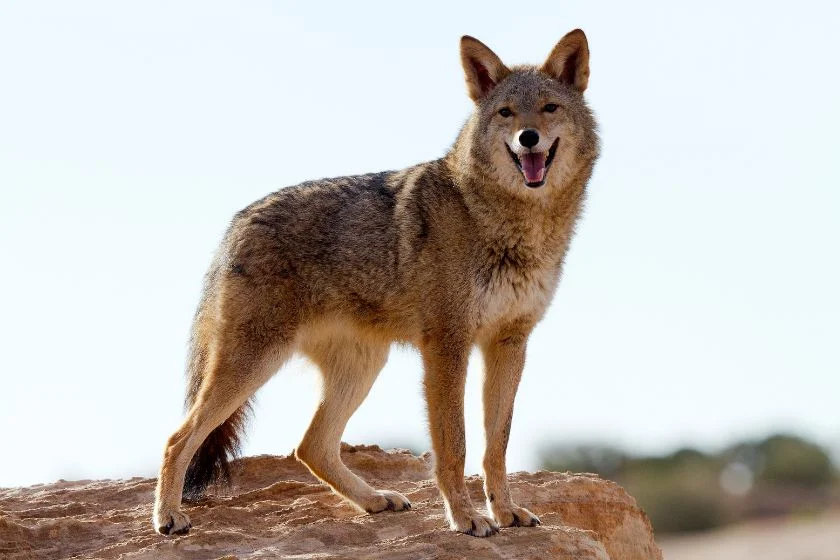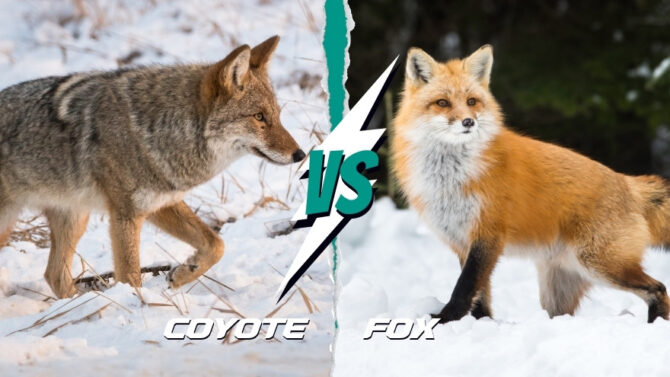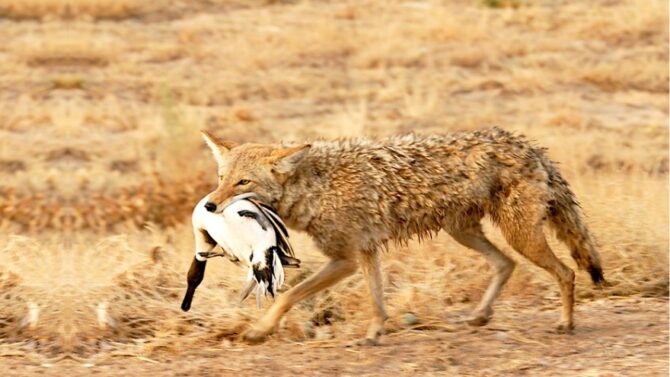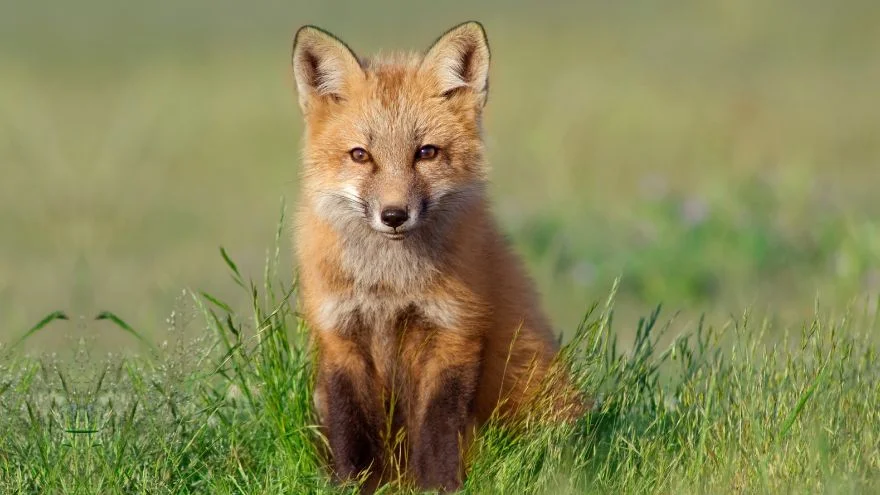Coyotes and foxes are two species of canids that are often found living in close proximity to each other, particularly in North America.
They are two of the most commonly mistaken animals; both are members of the Canidae family, which includes wolves, dogs, and jackals, and they share many physical and behavioral characteristics.
While they may look similar at first glance, there are actually several key differences between a coyote and a fox, which can help you tell them apart.
This article will explore some of the top differences and similarities between coyotes and foxes, so you can better understand these fascinating animals.
Coyote vs Fox: Comparison and Overview
If you’ve ever caught a fleeting glance of a wild dog strolling through your neighborhood, it was probably a fox or, depending on where you live, a coyote.
But how can the average person with no special animal experience distinguish a fox from a coyote?
Below is a quick overview of the main difference between a fox and a coyote.
| Coyote | Red Fox | |
|---|---|---|
| Height | 58 – 66 cm | 35 – 50 cm |
| Weight | 6.8 – 21 kg | 2.2 – 14 kg |
| Length | 76 – 86 cm | 45 – 90 cm |
| Colors | Mix of gray, light gray, red, peppered black and white mix | Black, silver, a mix of red and silver |
| Features | A coyote has a long, slender body with a bushy tail and sharp, pointed ears. | A red fox has a slender, agile body with a distinctive, bushy tail and pointed ears. |
| Range | North America | Worldwide |
About the Coyote

Coyotes (Canis latrans) are medium-sized carnivorous mammals native to North America. They are closely related to wolves and resemble small, lean versions of their larger relatives.
Coyotes are known for their intelligence and adaptability and have successfully colonized a wide range of habitats, including forests, grasslands, deserts, and even urban areas.
They are omnivorous and will eat a variety of foods, including small mammals, birds, reptiles, fruit, and insects.
Coyotes are also known for their distinctive vocalizations, which include howls, yips, and barks.
They are primarily active at dawn and dusk and often travel and hunt in packs.
Despite their reputation as pests in some areas, coyotes play important roles in the ecosystems in which they live and are protected in many parts of the United States.
Read on to discover the key distinctions between both animals.
About the Fox

Foxes are small-to-medium-sized carnivorous mammals belonging to the family Canidae.
There are over 30 species of fox, and they can be found on every continent except Antarctica.
Foxes are known for their intelligence and adaptability and have successfully colonized a wide range of habitats, including forests, grasslands, deserts, and even urban areas.
They are omnivorous and will eat a variety of foods, including small mammals, birds, reptiles, fruit, and insects.
Foxes are also known for their distinctive appearance, which includes a pointed snout, sharp teeth, and a bushy tail.
They are typically active at dawn and dusk and are known for their vocalizations, which include barks, howls, and whimpers.
Foxes play important roles in the ecosystems in which they live and are protected in many parts of the world.
Physical Differences Between Coyotes and Foxes
Size
The primary distinction between coyotes and foxes is their size. Coyotes are typically larger than foxes.
Coyotes weigh an average of 20 to 50 pounds, while foxes weigh only 8 to 15 pounds.
Coyotes are evolved to live in a range of habitats, including forests, grasslands, and even urban areas, but foxes are typically found in more rural or wilderness settings, which accounts for a substantial portion of their size disparity.
Appearance
The appearance of coyotes and foxes is another important distinction. Coyotes resemble dogs more than humans because of their long snouts, big ears, and bushy tails.
On the other hand, foxes resemble cats more because of their pointed tail, short ears, and narrow snout.
In addition, foxes appear in various colors, including red, grey, and black, whereas coyotes are typically brown or light grey.
Tail Shape
They can be distinguished by their tails’ shape. Coyotes typically have bushy, densely furred tails low to the ground.
On the other hand, foxes have a tail typically held vertically when running or alert and are considerably thinner and more pointed.
Coat Color
The coyote typically has red along the flanks and varied colors of gray throughout. In contrast, each species’ coat color for foxes is unique.
The most popular coat colors are red, gray, silver, and yellowish-brown.
The red fox’s gray color variant and the gray fox, a distinct species from the red fox, are likely the ones that people are most likely to mistake for coyotes.
Behavioral Differences Between a Fox and a Coyote
Living Arrangements and Social Interactions
Coyotes and foxes have diverse living arrangements, social behaviors, and different routines.
Foxes are often more solitary animals, but coyotes are more gregarious and frequently live in packs.
Foxes often favor more rural settings, whereas coyotes are more versatile and may survive in various habitats, including urban ones.
Vocalizations
Coyotes are known to be very vocal. Their vocalizations include protracted, wolf-like howls punctuated with yips, yelps, and barks, which are also well-known.
On the other hand, foxes are renowned for their high-pitched cries, which they use to communicate with other foxes (they sound very little like a wolf or dog).
Aggression and Behavior Towards Humans
Foxes often pose no threat to you, your family, or your pets. They are not considered harmful and hardly ever attack people unless they are rabid, which is uncommon. They naturally prefer to turn and flee than stay and fight.
On the other hand, coyotes are notorious for sneaking into residential areas and stealing small dogs and cats to eat.
Although they rarely attack people, this does not imply that you should approach a coyote and try to touch it if you see one because it is still a wild animal and may attack if startled or disturbed.
Other Differences Between a Coyote and a Fox
- Hunting Habits: Foxes are nocturnal animals, and although coyotes can hunt during this time, too, they’re more classified as diurnal animals.
- Diet: Coyotes and foxes can consume similar things, such as smaller animals. However, coyotes have larger bodies and can hunt deer and other large animals.
- Size of Poop: Coyote vs fox poop typically differ in size but have a similar appearance. Fox scat, also known as excrement, is typically two inches long, while a coyote’s scat can reach four inches.
- Geographic Distribution: The geographical range of foxes is substantially larger than that of the coyote, whose habitat is primarily in North and South America. Foxes are distributed all over the world.
- Mating Bonds: Coyotes have higher “pair bonds” during mating than foxes.
- Lifespan: Generally, coyotes live longer than foxes do. Coyotes have an average lifespan of about 10 years, but in captivity, they have been known to live up to 14 years. The typical lifespan is considerably lower in the wild, though, because of sickness, predators, and hunting. However, foxes only live one to four years on average.1
- Gestation Period: Compared to coyotes, foxes have a shorter gestation period. It will take Fox about 53 days, while coyotes that mate from January to February have a 60-day gestation period.
Coyote vs Fox: Top Key Similarities
Despite the obvious differences, there are also several similarities between coyotes and foxes.
The ability of foxes and coyotes to adapt to new habitats is one of the species’ most intriguing similarities.
Coyotes, particularly, are exceptionally adaptive, thriving in rural and urban settings.
Foxes, on the other hand, are better suited to living in wilderness environments, though they have also been observed to flourish in urban settings.
Despite being omnivorous, both animals fall into the carnivore category most often. They live in packs and are gregarious creatures, with the alpha male and female acting as the group’s leaders.2
Additionally, coyotes and foxes interact with one another using vocalizations and scents.
Related: Coyote vs Wolf vs Fox: What Are The Differences?
Frequently Asked Questions
What is the main difference between a fox and a coyote?
Size and body shape make up most of the differences between the two species. The coyote is substantially bigger than the other dog breeds, with longer legs, a stronger body, and a shorter tail. The fox, in comparison, has a smaller body, a bushier tail, and shorter legs.
Can a fox mate with a coyote?
Because they are not members of the same genus, foxes cannot breed or interbreed with dogs, coyotes, or wolves.
What is the relationship between foxes and coyotes?
Coyotes and foxes are members of the Canidae, also referred to as the “canines” family.
Conclusion
While coyotes and foxes may seem similar at first glance, they are quite different animals with unique physical and behavioral characteristics.
Whether you’re a nature enthusiast or just interested in learning more about these fascinating animals, understanding the key differences and similarities between the two species is vital.
It can help you better appreciate the diversity of the Canidae family and the amazing adaptations that allow these animals to thrive in their respective habitats.
Next up…
- What Eats Coyotes? (10 Coyote Predators With Pictures)
- Can Coyotes Climb Trees? (How High & How Fast?)
- What Is A Baby Fox Called? (Facts With Cute Pictures)
References & Notes
- Osterloff E. 2019. The secret life of urban foxes. Natural History Museum.
- General Information About Coyotes. Urban Coyote Research.






